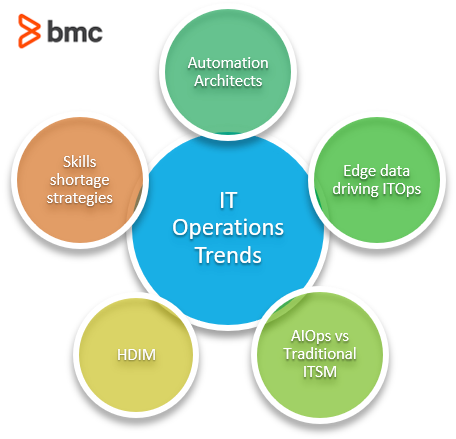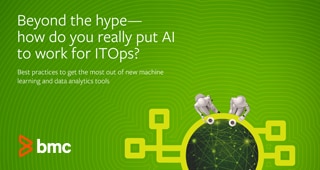Business organizations are increasingly challenged to operate highly scalable IT infrastructure—all while maintaining:
- Low costs
- High performance
- Minimal security risks
Both IT operations personnel and technology solutions are critical to achieving these goals. Maturing cloud infrastructure strategies are giving rise to trends in the IT Operations domain that require organizations to invest in new technology trends and skills. These are the biggest IT Operations trends for 2021.

1. The Automation Architect role
Automation is becoming a vehicle for DevOps and Agile-based infrastructure operations, but organizations investing in the technology recognize two challenges:
- Hybrid IT infrastructure operations are complex, making it difficult to establish unified, scalable and efficient automation workflows.
- Automating waste processes only slows down the overall SDLC pipeline. According to recent research, 68% of the surveyed IT professionals report that their IT environments are significantly more complex than they were only two years prior.
As a result, many organizations are employing a new role: dedicated Automation Architects. Gartner predicts that these positions currently held at 20% of the organizations will increase to 90% of enterprises by the year 2025.
2. Edge data driving IT operations
Gartner finds that, by 2022, 60% of enterprise IT infrastructure will focus on “centers of data”. This means that data will inherently motivate IT operations decisions, frameworks, and workflows.
According to an IDC study, more than 50% of the infrastructure will be deployed at the network edge by the year 2023. This trend suggests that more data will be generated, processed, and stored closer to the edge of the network infrastructure. By 2024, the number of apps running on this infrastructure will also increase by 800%!
From a daily job routine perspective, IT ops will increasingly focus on the associated metrics that define real-time user experience, focused both on security and performance of the apps. In order to prepare for the transition, organizations are increasingly investing in public cloud and hybrid IT infrastructure solutions. Investments in Infrastructure as a Service (IaaS) are much needed among SMB firms; the cloud-related skills gap, however, continues to slow these investments.
3. AI Ops vs traditional ITSM
Modern SDLC frameworks such as Agile and DevOps encourage organizations to adapt to change. But IT operations workflows, when complying with traditional ITSM frameworks, typically prefer risk-averse and non-dynamic behavior of the infrastructure. DevOps teams now rely on advanced AI/ML solutions that automate and optimize the necessary infrastructure changes dynamically, adapting the ITSM process for changing business requirements.
This means that dependence on traditional ITSM methodologies is reduced, replaced by AIOps technology solutions. In general, this may suggest that traditional ITSM will become redundant once AIOps technologies reach maturity and are readily adopted across the industry.
This trend is apparent in the popularity of AIOps technologies as the market is set to increase by 32% CAGR and reach $237 billion by 2025.
4. Hybrid Digital Infrastructure Management (HDIM)
An emerging trend toward digital transformation in context of IT operations is Hybrid Digital Infrastructure Management (HDIM), a unified management solution for hybrid IT infrastructure systems. The technology integrates and bundles multiple capabilities used in the daily routine of IT Ops personnel, including:
- Infrastructure management
- Data management
- Cloud management
- Other ITSM capabilities
HDIM technology is yet to reach a state of maturity, though some enterprises are leading the way as early adopters. By 2022, Gartner expects 20% of enterprises to leverage HDIM technologies to optimize hybrid IT infrastructure operations.
The technology complements the use of AIOps capabilities that will be built into unified management solutions, designed to optimize infrastructure operations processes. These will be primarily based on contextual information driven by vast streams of data generated at the network edge through infrastructure logs, IoT devices, and apps.
5. Skills shortage remains problematic
One of the motivations for the growing popularity of technologies like AIOps and HDIM is the prevalent skills shortage in the IT Operations domain. According to 451 Research, a variety of operational roles ranging from SysAdmins to data scientists and developers are in high demand and short supply.
The highest skills shortage is observed in these roles:
- Server/Systems administration (43%)
- DevOps (41%)
A significant proportion of these roles remain unfilled and according to IDC. 30% of IT roles will remain vacant through the year 2022. CIOs are expected to focus their hirings on two key areas:
- The adoption of data-driven and AI capabilities
- The end-to-end SDLC lifecycle management, per best practice frameworks such as DevOps, Agile, and SRE
Additional resources
For more information, explore these related resources:
- BMC IT Operations Blog
- IT Operations Best Practices
- IT Operations & AIOps Adoption: Feedback from the Frontline
- How to Solve the IT Skills Shortage
- Digital Transformation Trends
Get practical guidance for AIOps
These postings are my own and do not necessarily represent BMC's position, strategies, or opinion.
See an error or have a suggestion? Please let us know by emailing blogs@bmc.com.






